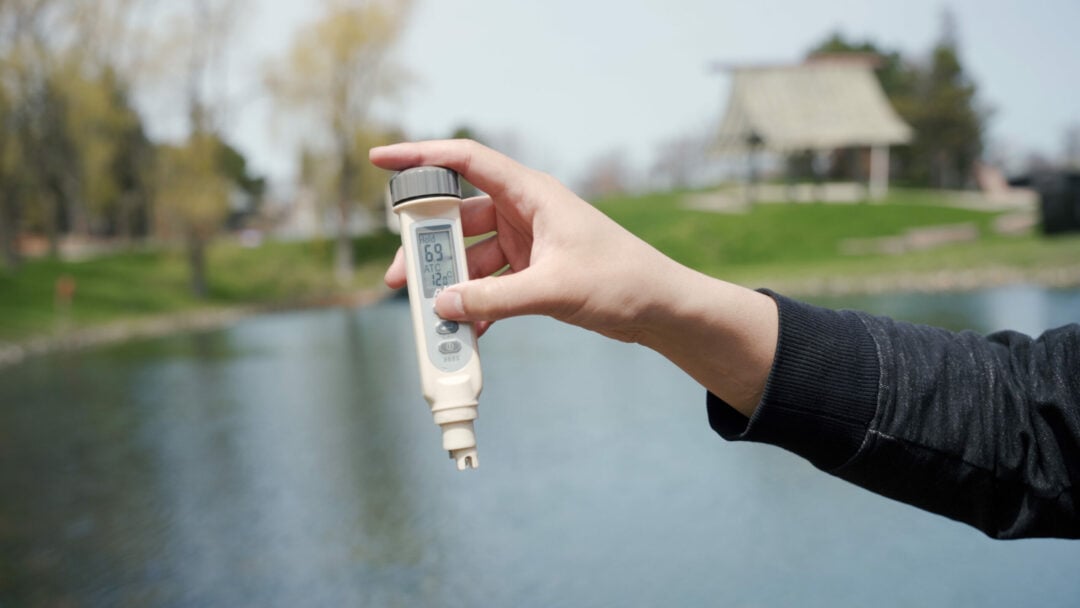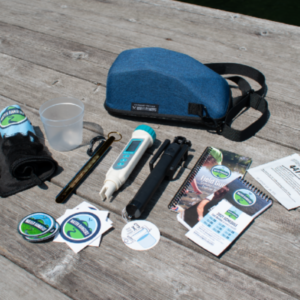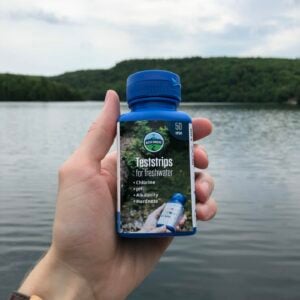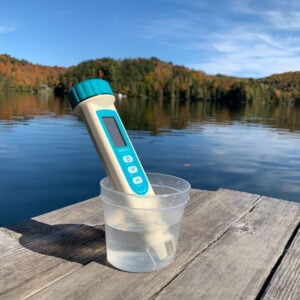Description
pH is one of the most important parameters to monitor for water health. pH stands for “potential for Hydrogen”. It is the measure of the acidity or alkalinity of water soluble substances.
Our pH meter is lightweight, easy to use, and accurate. If you need a quick and easy way of sampling pH, this is the tool for you! The pH meter offers accurate pH readings from 0-14, as close as +/- 0.2pH, and temperature readings within one degree! Calibration is done in with solution pouches or powders in three easy steps a 4, 7, and 10.
How to calibrate and use a pH meter
We need to ensure our pH meters are accurate at all times. For this reason, the pH meter needs to be calibrated often, ideally ahead of each sampling excursion. Without the calibrations, the meter readings can drift over time, leading to inaccuracies. If you are testing on a daily basis, the meters should be calibrated daily.
For calibration with a liquid solutions these are the items you will need to calibration your pH meter:
- pH packets provided in the your testkits with the pH of 4, 7, 10.
- Jars or bottles that can hold at least 250 mL of liquid.
- 4 litres of distilled water for calibration solutions and rinsing.
- Water Rangers cloth for cleaning/wiping.
To perform the calibration you will need to follow these steps:
- Set out 3 clean, resealable jars or bottles with 250mL
- Label containers for each pH (or buffer) solution: 4, 7, 10.
- Open calibration packets and pour contents of each pH range into separate containers (follow the labels).
- Take out your pH meter and power it on.
- Place the meter in buffer solution 7. Always start with the solution with the pH of 7, and then move onto 4 then 10 for better accuracy.
- Press “CAL” on the pH meter to start the calibration process. The meter will flash 4, 7, OR 10. You will also see “Cal” in the top of the screen. This means it is ready to be calibrated.
- If the probe successfully recognizes the buffer, the buffer pH value “7.0” will appear on the display in 2 seconds.
- Once the meter reads a stable buffer value (pH 7.0 for example), without pressing a single key, the meter will automatically save the value (SA will appear on the screen) and return to the measurement screen.
- Rinse in distilled water, dab to dry, and repeat this process for pH 4 and pH 10. Make sure to rinse meter before moving between buffer solutions.
- NOTE***During calibration, if the calibration buffer is not 4,7,10 but another value, such as 4.01, just press “HLD” to change the value.
- Store calibration solution in a cool location. They can last up to 3-4 weeks and can be reused.
For calibration with powders these are the items you will need to calibrate your pH meter:
- pH packets with the pH of 4, 7, 10.
- Jars or bottles that can hold at least 250 mL of liquid.
- 4 litres of distilled water for calibration solutions and rinsing.
- Water Rangers cloth for cleaning/wiping.
To perform the calibration you will need to follow these steps:
- Fill 3 clean, resealable jars or bottles with 250mL of distilled water each
- Label containers for each pH solution: 4, 7, 10.
- Open calibration packets and pour contents of each pH range into separate containers (follow the labels).
- Stir with clean utensil and wait for 30 minutes or until the powders have completely dissolved.
- Take out your pH meter and power it on.
- Place the meter in buffer solution 7. Always start with the solution with the pH of 7, and then move onto 4 then 10 for better accuracy.
- Press “CAL” on the pH meter to start the calibration process. The meter will flash 4, 7, OR 10. You will also see “Cal” in the top of the screen. This means it is ready to be calibrated.
- If the probe successfully recognizes the buffer, the buffer pH value “7.0” will appear on the display in 2 seconds.
- Once the meter reads a stable buffer value (pH 7.0 for example), without pressing a single key, the meter will automatically save the value (SA will appear on the screen) and return to the measurement screen.
- Rinse in distilled water, dab to dry, and repeat this process for pH 4 and pH 10. Make sure to rinse meter before moving between buffer solutions.
- NOTE***During calibration, if the calibration buffer is not 4,7,10 but another value, such as 4.01, just press “HLD” to change the value.
- Store calibration solution in a cool location. They can last up to 3-4 weeks and can be reused.
Taking a measurement with the pH meter
-
- Rinse sample cup 3 times before taking the final sample for the measurement. If possible and safe to do so, you can also dip the meter right into the waterbody.
- Dip the meter into the water and wait for the number on the screen to stabilize before recording the number. You can even press the “HLD” or the hold button to freeze the reading so you can take notes without it changing.
- Since pH is affected by water temperature, you should also use this to record water temperature.
- After the measurement, be sure to rinse the probe with distilled water before the next measurement or before putting it away.
Things to keep in mind!
- To prolong the life of the meter, make sure to keep the pH glass bulb wet by using the cap to protect and store the electrode.
- Make sure to always rinse the probe of the meter before using and between measurements.
- NEVER touch the glass bulb as it is very delicate and can alter your readings.
- If you are testing on a monthly basis, you will have to calibrate the meter every time before heading out.




